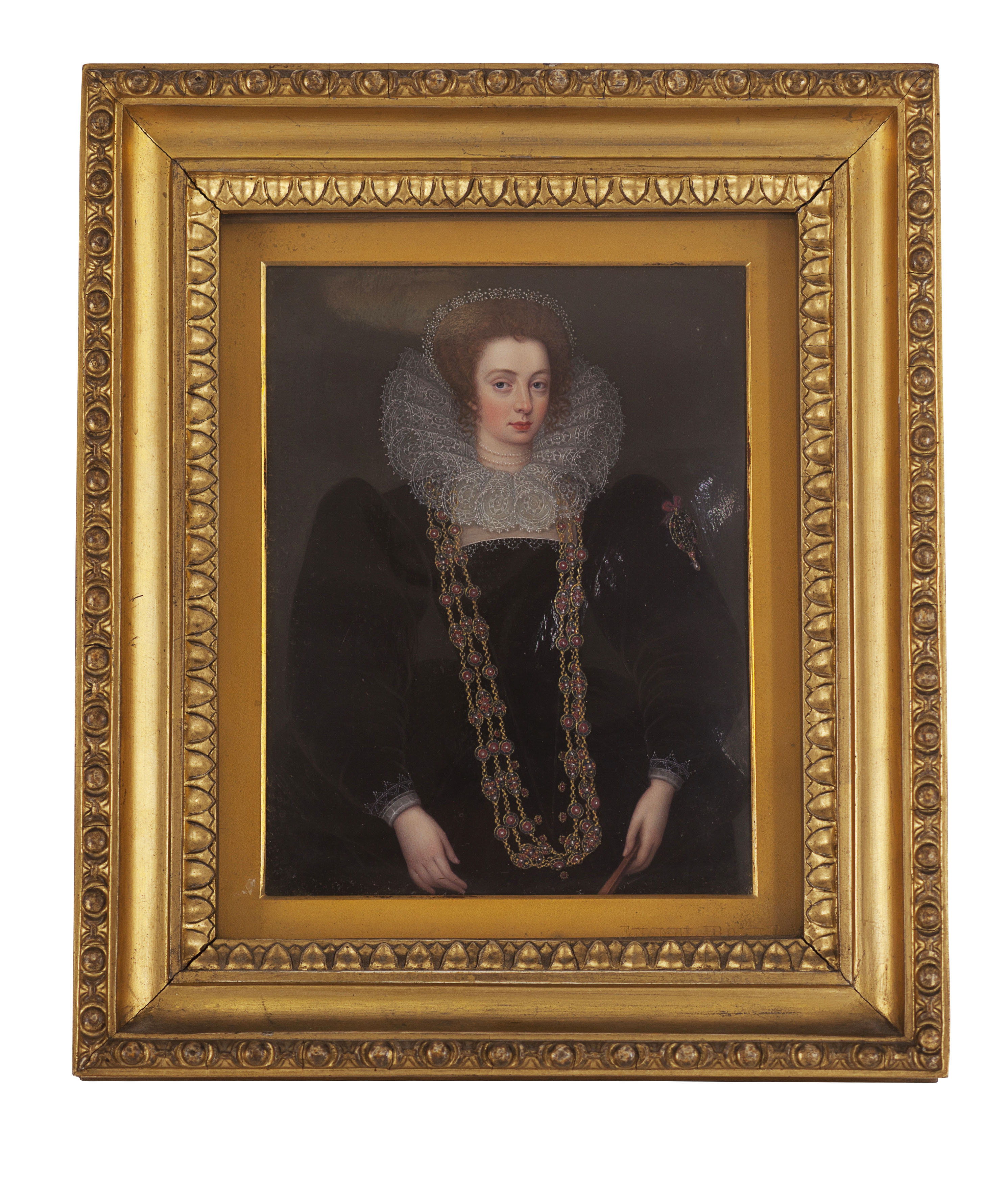HENRY BONE, R.A. (BRITISH, 1755-1834)
ELIZABETH CAREY, DAUGHTER OF LORD HUNSDON, AFTERWARDS LADY BERKELEY
£9,375
Auction: 14 January 2015 at 11:00 GMT
Description
enamel on copper, three quarter length portrait, in a black velvet dress with lace ruff collar and double strand pearl choker, and wearing a long triple strand gold chain, garnet and seed pearl necklace, in a gilt gesso frame, inscribed on the slip 'ENAMEL H BONE, R.A.', paper exhibition label to the reverse
Dimensions
18cm x 13.75cm
Footnote
Note: Elizabeth Carey (1576-1635) was the only child of George Carey, 2nd Baron Hunsdon and Elizabeth Spencer. She was a courtier and patroness of the Arts, and the dedicatee of works by Thomas Nashe. She married Sir Thomas Berkeley in 1596, aged 19, and after his death in 1611 remarried Sir Thomas Chamberland in 1622. Bone's portrait is after the original at Berkeley Castle.
Provenance: The Collection of Lady Lanesborough, previously at Swithland Hall, Leicestershire.
Henry Bone (1755-1834)
The son of a cabinet maker and carver, Henry Bone (1755- 1834) was born in Cornwall in 1755. Appointed Enamel Painter to George III, the Prince of Wales (later George IV), and William IV, and a Royal Academy Member, he became famous for the skill and scale of his works, his copies after oil paintings gaining him the reputation as the 'Prince of Enamellers'.
Starting as an apprentice at the Plymouth Porcelain Works, he moved on to the Bristol China Works in 1772. Over the following six years Bone developed his talent, dedicating himself to china decoration and artistic studies. Upon the closure of the Bristol China Works in 1779, he moved to London and found employment decorating fans and watches before his first Royal Academy Exhibition in 1781. Following the exposure he gained from these exhibitions he decided to focus solely on enamel painting, a regular feature at the Royal Academy. He exhibited A Muse and Cupid in 1789, at the time the largest enamel painting ever executed. He later went on to surpass himself in 1811 with his most famous piece, a work after Titian's Bacchus and Ariadne. Previous work in enamel had only been a few inches across, featuring in miniatures and jewellery. At the time the process involved bonding the enamel paint onto a metal sheet, usually copper, through a firing process. The firing would often last for several hours but as the colours would fuse at different temperatures, there was a risk that certain paints may crack and buckle while others were still setting. To reduce the risk of deformation artists would only enamel onto small pieces. Bone experimented with the firing process as well as with his enamel paint formulas and developed enamel paints that would fuse reliably within a narrow heat range and true to colour, enabling him to produce such large, high quality works.
Henry Bone's stature had grown so much that he received 4,000 visitors while exhibiting Bacchus and Adrianne at his house in Berners Street, eventually selling it for the large sum on 2200 guineas. It is now in the collection of the Cleveland Museum of Art, who purchased it at auction in 2013 for £313,875. His next great projects included a series of eightyfive historical portraits of figures from the time of Elizabeth I, a series of Civil War cavaliers, and also a series of portraits of members of the Russell family. While the Elizabethan portraits were not a financial success for Bone they are considered among his greatest works.
The portraits in our sale are prime examples of Bone's prowess, skill and attention to detail. The portrait of Elizabeth Carey, later Lady Berkeley, is a cool study of Elizabethan composure, wealth and status. Bone's original pencil grid sketch for this portrait in the collection of the National Portrait Gallery illustrates his meticulous precision.
Suffering from failing eyesight and poor health, Bone offered to sell his collection of enamels to the nation but it was declined. After his death in 1834, it was dispersed and sold at auction by Christie's in 1836. It is believed these four came into the collection of the 5th Earl of Lanesborough, who was furnishing Swithland Hall at this time. It is a rarity to have four of Henry Bone's remarkable portraits available at one time and from one source.

